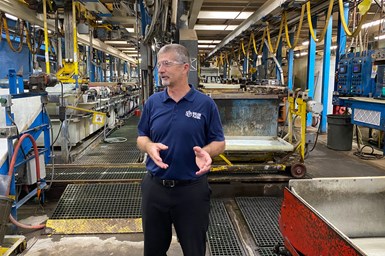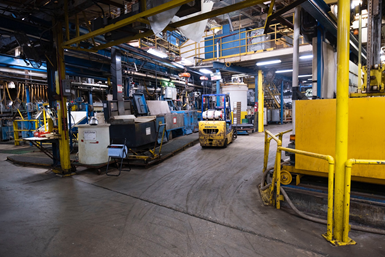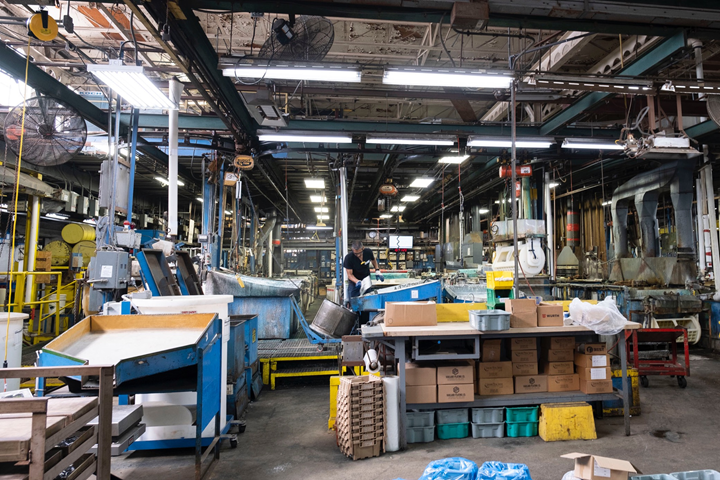Varland Plating is a one-stop shop for barrel-plated parts, which the company has been churning out from its facility just north of downtown Cincinnati, Ohio since 1946. The shop is one of Products Finishing’s 2022 Plating and Anodizing Top Shops, and one of the recurring themes from our recent visit to the facility was a commitment to continuous improvement.
Varland’s current process offerings include electroless nickel (EN), electrolytic nickel, zinc-nickel, tin-zinc, copper, brass and more. Over the years, the company has steadily added more processes and upgraded its existing ones, and now, with recently appointed President Brian Mangold at its helm, the shop is investing in ways to be more efficient and cost-effective while setting itself up for future growth.
Featured Content
Mangold, who has been with Varland for 31 years, took over as president after Ross Varland stepped down from the role in March 2022. As Mangold walks the shopfloor, he speaks of how the shop has been overcoming a number of curveballs over the last few years, such as labor shortages, supply chain issues and other hurdles that many finishers currently face. It hasn’t always been easy, but Mangold’s vision of how the shop can grow has carried it through.
System upgrades to drive growth
The first order of business on Mangold’s to-do list is to add a new EN line. During PF’s visit to Varland, a large section of the shopfloor was cleared out to make room for a new system being installed, which will feature mid- and high-phosphorous EN plating over steel, copper, brass and aluminum substrates. “EN has been growing a lot. It used to be a very small percentage of our business,” Mangold says, adding, “Zinc-nickel has been a huge growth point for us, as well as tin. We have lots of room to grow, we just need to find the work.”
The company has also set a long-term goal of upgrading its constantly running hand line to a more automated solution. According to Mangold, automating this line — which is one of the shop’s busiest — would keep orders moving while also enabling operators step away to focus on quality inspection and other off-the-line work that is required to run the shop.
Varland already relies on automation solutions to keep lines running, make up for shortages on the team and boost production. The new automated EN line adds to Varland’s three other fully automated plating lines for processing copper, nickel, zinc-nickel, tin-zinc, zinc and matte and bright tin. “Automating the handline is really the final step in fully automating all of our plating systems,” Mangold says. “With automation, everything is repeatable — and repeatability drives quality.”
Keeping tabs on orders
One aspect of Varland that is unique to the shop is how it tracks orders. In the early 1980s, Varland created the first iteration of its proprietary job management system, the Varland Computerized Management System (VCMS) to keep track of orders as they arrive, move throughout the shop and are exported through its packaging and shipping area. The VCMS enables the team to stay organized and monitor the status of each order in real time. The system also keeps all the data from each order so the shop can reference back and track its productivity, as well as ensure everything is running properly.
Varland used to support other finishing companies in adopting the VCMS platform for their own processes, and at one time had nearly a dozen other operations using the software. Varland’s support for other shops using the platform has since ended, but they were provided the source code so they could continue to use, adapt and upgrade it for themselves.
Varland’s quality management system became ISO 9001:2000 certified in 2003, and Mangold says the certification “has definitely been a benefit. Setting the system up with our internal quality management system has allowed us to grow and improve here, and make things more structured.”
An additional aspect of the shop that stands out is how it treats its hazardous waste. Since 1993, Varland has been treating and recycling its hazardous waste. “All of our hazardous waste gets recycled,” Mangold says. “[The shop’s processor] reclaims all the metal out and it gets circled back” into the shop’s processes, which keeps it from ending up in landfills.
Recognizing excellence in metal finishing
Varland’s place on the PF’s Top Shops list is far from the first recognition it has received. Notably, the shop was the first metal finishing shop to win Ford Motor Company’s Q1 Award, which it won in 1981 in recognition of its quality products and dedication to continuous improvement. While the commemorative plaque has drawn some dust from years spent hanging in Varland’s front office, it represents the plating shop’s past achievements and acts as a reminder of how far it has come. With a Top Shops plaque to soon accompany it, Varland looks toward a future as bright as the parts it plates.
RELATED CONTENT
-
Electroless Nickel Conference 2023: Learn, Solve, Network
The Electroless Nickel Conference 2023 takes place Sept. 26-29th in Milwaukee, Wisconsin.
-
Possibilities From Electroplating 3D Printed Plastic Parts
Adding layers of nickel or copper to 3D printed polymer can impart desired properties such as electrical conductivity, EMI shielding, abrasion resistance and improved strength — approaching and even exceeding 3D printed metal, according to RePliForm.
-
Decreasing EN Plating Costs with Single-Component Solution
Detailed calculations of the true cost of electroless nickel plating reveals how converting to single-component EN solution can reduce costs and save time.

























